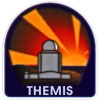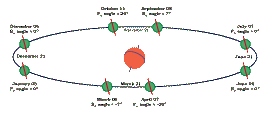
Return to Ephemeris
Page
The calculations for these ephemerides are based on the
formulas given by Jean Meeus in his excellent Astronomical Algorithms
(1991, Willman-Bell, Inc.,Richmond, Virginia, USA). Calculations are performed
in the Procedural SQL (PL/SQL) programming language.
A Note on Accuracy: The accuracy of the calculations of the
heliographic elements and the sun's positions, should be in general better than
0.01 degrees, or approximately 30 seconds of arc, especially in the present
epoch. The times of rise and set should be accurate to approximately 1-2
minutes, which is acceptable when considering that uncertainities in the
atmospheric refraction, observer's altitude, and the true horizon will provide
an even greater variation in the actual times of rise and set. The transit times
are probably accurate to within approximately 10 seconds or better. As always,
while we have tried to test the programs thouroughly, there are no guarantees as
to the accuracy of the calculations.
Ephemeris Definitions -
- Po angle -
- the angle between the geocentric and heliocentric north poles of the Sun.
That is, the difference between the top of the Sun as seen from earth and the
northern extremity of the Sun's axis of rotation. As shown in Figure 1, this
angle changes during the course of the year due to the combination of the tilt
of the Sun's axis of rotation with respect to the plane of the earth's
revolution around the Sun (7.3 degrees) and the tilt of the earth's axis of
rotation with respect to its orbit (23.4 degrees). Figure 2
shows how these two effects combine to produce the observed Po
angle. Since the tilt of the earth's axis of rotation is the much larger of
these two values, it is no coincidence that the Po angle reaches
its extremes at approximately the same time as the equinoxes. The
Po angle is measured starting from the geocentric north pole and is
positive when the axis of rotation is tilted to the east of geocentric north,
and negative when the solar axis is titled to the west.
 Figure 1
Figure 1  Figure
2
Figure
2
- Bo angle -
- The heliographic latitude at the center of the solar disk as seen from
earth. This is due solely to the 7.35 degree difference in angles between the
earth's plane of revolution and the Sun's axis of rotation. This causes an
observer on the earth to be located above or below the sun's equator depending
on the time of year. The Bo angle is maximum in early september,
minimum in early March, and zero at the beginning of June and December.
- Carrington Rotation -
- The synodic rotation number of the Sun. The rotations of the Sun were
defined by R.C. Carrington (Observations of the Spots on the Sun, 1863)
assuming a rigidly rotating sun with a synodic rotation period of 27.2753
days. Carrington rotation #1 began on November 9, 1853 and a new rotation
begins each time the prime meridian of the Sun (i.e. where the heliographic
longitude is zero) passes the center point on the solar disk as seen from
earth. The accuracy of this calculation is should be better than 0.001.
- Carrington Longitude -
- The heliographic longitude of the disk center of the Sun. The heliographic
coordinates are computed assuming a rigid sphere rotating with a period of
27.2753 days.
- Semidiameter -
- The apparent angular diameter of the Sun assuming the a semidiamter of
959.63 seconds of arc at a distance of one Astronomical Unit.
- Image Scale -
- The length kilometers that corresponds to one second of arc at the center
of the solar disk. This assumes a true solar diamter of 696,000
kilometers
- Right Ascension and Declination -
- The Sun's position in the celestial coordinate system.
- Altitude and Azimuth -
- The current position of the center of sun in the sky from the given
position on the earth's surface. The Altitude ranges from zero degrees (the
horizon) to ninety degrees (directly overhead). Negative values indicate the
distance below the horizon (i.e. the sun is not visible). The Azimuth is the
compass direction of the sun and ranges from 0 to 360 degrees, with the zero
point being (arbitrarily) fixed as due north. The values increase as the
object moves to the east (90 degrees) and then due south (180 degrees) and
west (270 degrees).
- Rise, Transit, and Set Times -
- The times are calculated for the given date and location. The rise and set
times give the times, respectively, of the first and last and last appearance
of the Sun's disk above the horizon. The transit time is when the Sun is due
south and is highest in the sky that day, that is local noon. The times given
are all in Universal Time and can be converted to the local time zone as
desired. If the Sun does not rise or set that day (i.e. for high latitudes
during summer), the rise and set times will be listed as midnight.
Return to Ephemeris
Page
These pages designed and maintained by Kevin Reardon, kreardon@na.astro.it
ARTHEMIS / Osservatorio
Astronomico di Capodimonte


 Figure 1
Figure 1  Figure
2
Figure
2